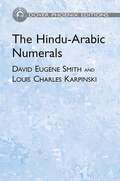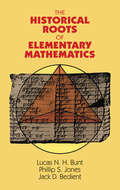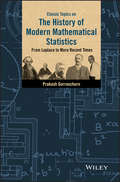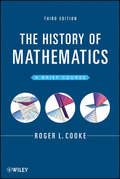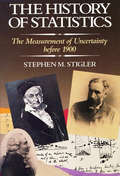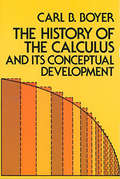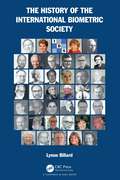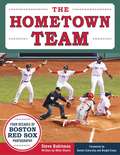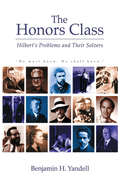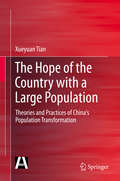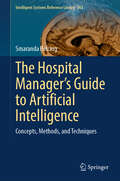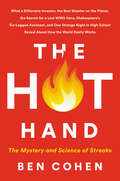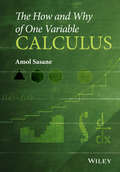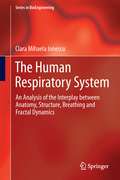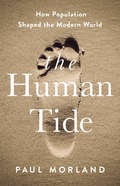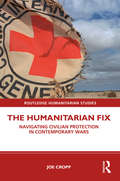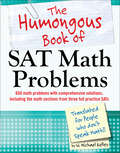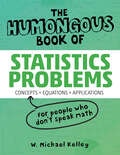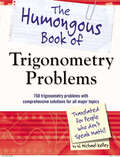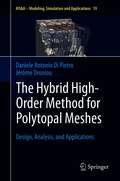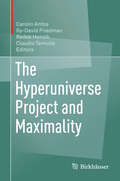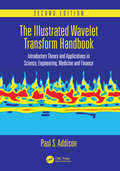- Table View
- List View
The Hindu-Arabic Numerals (Dover Books on Mathematics)
by David Eugene Smith Louis Charles KarpinskiThe numbers that we call Arabic are so familiar throughout Europe and the Americas that it can be difficult to realize that their general acceptance in commercial transactions is a matter of only the last four centuries and they still remain unknown in parts of the world.In this volume, one of the earliest texts to trace the origin and development of our number system, two distinguished mathematicians collaborated to bring together many fragmentary narrations to produce a concise history of Hindu-Arabic numerals. Clearly and succinctly, they recount the labors of scholars who have studied the subject in different parts of the world; they then assess the historical testimony and draw conclusions from its evidence. Topics include early ideas of the origin of numerals; Hindu forms with and without a place value; the symbol zero; the introduction of numbers into Europe by Boethius; the development of numerals among Arabic cultures; and the definitive introduction of numerals into Europe and their subsequent spread. Helpful supplements to the text include a guide to the pronunciation of Oriental names and an index.
The Historical Roots of Elementary Mathematics
by Lucas N. Bunt Jack D. Bedient Phillip S. Jones"Will delight a broad spectrum of readers." -- American Mathematical MonthlyDo long division as the ancient Egyptians did! Solve quadratic equations like the Babylonians! Study geometry just as students did in Euclid's day! This unique text offers students of mathematics an exciting and enjoyable approach to geometry and number systems. Written in a fresh and thoroughly diverting style, the text -- while designed chiefly for classroom use -- will appeal to anyone curious about mathematical inscriptions on Egyptian papyri, Babylonian cuneiform tablets, and other ancient records.The authors have produced an illuminated volume that traces the history of mathematics -- beginning with the Egyptians and ending with abstract foundations laid at the end of the 19th century. By focusing on the actual operations and processes outlined in the text, students become involved in the same problems and situations that once confronted the ancient pioneers of mathematics. The text encourages readers to carry out fundamental algebraic and geometric operations used by the Egyptians and Babylonians, to examine the roots of Greek mathematics and philosophy, and to tackle still-famous problems such as squaring the circle and various trisectorizations.Unique in its detailed discussion of these topics, this book is sure to be welcomed by a broad range of interested readers. The subject matter is suitable for prospective elementary and secondary school teachers, as enrichment material for high school students, and for enlightening the general reader. No specialized or advanced background beyond high school mathematics is required.
The History Of Modern Mathematical Statistics: From Laplace To More Recent Times
by Prakash Gorroochurn"There is nothing like it on the market. . . no others are as encyclopedic. . . the writing is exemplary: simple, direct, and competent. " -George Cobb, Professor Emeritus of Mathematics and Statistics, Mount Holyoke College Written in a direct and clear manner, Classic Topics on the History of Modern Mathematical Statistics: From Laplace to More Recent Times presents a comprehensive guide to the history of mathematical statistics and details the major results and crucial developments over a 200 year period. Presented in chronological order, the book features an account of the classical and modern works that are essential to understanding the applications of mathematical statistics. Divided into three parts, the book begins with extensive coverage of the probabilistic works of Laplace, who laid much of the foundations of later developments in statistical theory. Subsequently, the second part introduces 20th century statistical developments including work from Karl Pearson, Student, Fisher, and Neyman. Lastly, the author deals with post-Fisherian developments. Classic Topics on the History of Modern Mathematical Statistics: From Laplace to More Recent Times also features: A detailed account of Galton's discovery of regression and correlation as well as the subsequent development of Karl Pearson's X2 and Student's t A comprehensive treatment of the permeating influence of Fisher in all aspects of modern statistics beginning with his work in 1912 Significant coverage of Neyman-Pearson theory, which includes a discussion of the differences to Fisher's works Discussions on key historical developments as well as the various disagreements, contrasting information, and alternative theories in the history of modern mathematical statistics in an effort to provide a thorough historical treatment Classic Topics on the History of Modern Mathematical Statistics: From Laplace to More Recent Times is an excellent reference for academicians with a mathematical background who are teaching or studying the history or philosophical controversies of mathematics and statistics. The book is also a useful guide for readers with a general interest in statistical inference.
The History Of New York City: Understand Properties Of Multiplication (Rosen Common Core Math Readers Ser.)
by Katie WhiteIn this book, readers will take a tour of major New York City historical attractions while learning how to use properties of operations for multiplication and division. This volume meets CCSS Math Standard 3.OA.B.5.
The History of Correlation
by John Nicholas ZorichAfter 30 years of research, the author of The History of Correlation organized his notes into a manuscript draft during the lockdown months of the COVID-19 pandemic. Getting it into shape for publication took another few years. It was a labor of love.Readers will enjoy learning in detail how correlation evolved from a completely non-mathematical concept to one today that is virtually always viewed mathematically. This book reports in detail on 19th- and 20th-century English-language publications; it discusses the good and bad of many dozens of 20th-century articles and statistics textbooks in regard to their presentation and explanation of correlation. The final chapter discusses 21st-century trends.Some topics included here have never been discussed in depth by any historian. For example: Was Francis Galton lying in the first sentence of his first paper about correlation? Why did he choose the word "co-relation" rather than "correlation" for his new coefficient? How accurate is the account of the history of correlation found in H. Walker's 1929 classic, Studies in the History of Statistical Method? Have 20th-century textbooks misled students as to how to use the correlation coefficient?Key features of this book: Charts, tables, and quotations (or summaries of them) are provided from about 450 publications. In-depth analyses of those charts, tables, and quotations are included. Correlation-related claims by a few noted historians are shown to be in error. Many funny findings from 30 years of research are highlighted. This book is an enjoyable read that is both serious and (occasionally) humorous. Not only is it aimed at historians of mathematics, but also professors and students of statistics and anyone who has enjoyed books such as Beckmann's A History of Pi or Stigler's The History of Statistics.
The History of Mathematics
by Roger L. CookeThis Third Edition of The History of Mathematics examines the elementary arithmetic, geometry, and algebra of numerous cultures, tracing their usage from Mesopotamia, Egypt, Greece, India, China, and Japan all the way to Europe during the Medieval and Renaissance periods where calculus was developed. Aimed primarily at undergraduate students studying the history of mathematics for science, engineering, and secondary education, the book focuses on three main ideas: the facts of who, what, when, and where major advances in mathematics took place; the type of mathematics involved at the time; and the integration of this information into a coherent picture of the development of mathematics. In addition, the book features carefully designed problems that guide readers to a fuller understanding of the relevant mathematics and its social and historical context. Chapter-end exercises, numerous photographs, and a listing of related websites are also included for readers who wish to pursue a specialized topic in more depth. Additional features of The History of Mathematics, Third Edition include:Material arranged in a chronological and cultural context. Specific parts of the history of mathematics presented as individual lessons. New and revised exercises ranging between technical, factual, and integrative. Individual PowerPoint presentations for each chapter and a bank of homework and test questions (in addition to the exercises in the book) An emphasis on geography, culture, and mathematics. In addition to being an ideal coursebook for undergraduate students, the book also serves as a fascinating reference for mathematically inclined individuals who are interested in learning about the history of mathematics.
The History of Statistics: The Measurement of Uncertainty before 1900
by Stephen M. StiglerThis magnificent book is the first comprehensive history of statistics from its beginnings around 1700 to its emergence as a distinct and mature discipline around 1900. Stephen M. Stigler shows how statistics arose from the interplay of mathematical concepts and the needs of several applied sciences including astronomy, geodesy, experimental psychology, genetics, and sociology. He addresses many intriguing questions: How did scientists learn to combine measurements made under different conditions? And how were they led to use probability theory to measure the accuracy of the result? Why were statistical methods used successfully in astronomy long before they began to play a significant role in the social sciences? How could the introduction of least squares predate the discovery of regression by more than eighty years? On what grounds can the major works of men such as Bernoulli, De Moivre, Bayes, Quetelet, and Lexis be considered partial failures, while those of Laplace, Galton, Edgeworth, Pearson, and Yule are counted as successes? How did Galton’s probability machine (the quincunx) provide him with the key to the major advance of the last half of the nineteenth century? Stigler’s emphasis is upon how, when, and where the methods of probability theory were developed for measuring uncertainty in experimental and observational science, for reducing uncertainty, and as a conceptual framework for quantitative studies in the social sciences. He describes with care the scientific context in which the different methods evolved and identifies the problems (conceptual or mathematical) that retarded the growth of mathematical statistics and the conceptual developments that permitted major breakthroughs. Statisticians, historians of science, and social and behavioral scientists will gain from this book a deeper understanding of the use of statistical methods and a better grasp of the promise and limitations of such techniques. The product of ten years of research, The History of Statistics will appeal to all who are interested in the humanistic study of science.
The History of the Calculus and Its Conceptual Development
by Carl B. BoyerThis book, for the first time, provides laymen and mathematicians alike with a detailed picture of the historical development of one of the most momentous achievements of the human intellect - the calculus. It describes with accuracy and perspective the long development of both the integral and the differential calculus from their early beginnings in antiquity to their final emancipation in the 19th century from both physical and metaphysical ideas alike and their final elaboration as mathematical abstractions, as we know them today, defined in terms of formal logic by means of the idea of a limit of an infinite sequence.But while the importance of the calculus and mathematical analysis - the core of modern mathematics - cannot be overemphasized, the value of this first comprehensive critical history of the calculus goes far beyond the subject matter. This book will fully counteract the impression of laymen, and of many mathematicians, that the great achievements of mathematics were formulated from the beginning in final form. It will give readers a sense of mathematics not as a technique, but as a habit of mind, and serve to bridge the gap between the sciences and the humanities. It will also make abundantly clear the modern understanding of mathematics by showing in detail how the concepts of the calculus gradually changed from the Greek view of the reality and immanence of mathematics to the revised concept of mathematical rigor developed by the great 19th century mathematicians, which held that any premises were valid so long as they were consistent with one another. It will make clear the ideas contributed by Zeno, Plato, Pythagoras, Eudoxus, the Arabic and Scholastic mathematicians, Newton, Leibnitz, Taylor, Descartes, Euler, Lagrange, Cantor, Weierstrass, and many others in the long passage from the Greek "method of exhaustion" and Zeno's paradoxes to the modern concept of the limit independent of sense experience; and illuminate not only the methods of mathematical discovery, but the foundations of mathematical thought as well.
The History of the International Biometric Society
by Lynne BillardThe International Biometric Society (IBS) was formed at the First International Biometric Conference at Woods Hole on September 6, 1947. The History of the International Biometric Society presents a deep dive into the voluminous archival records, with primary focus on IBS’s first fifty years. It contains numerous photos and extracts from the archival materials, and features many photos of important leaders who served IBS across the decades. Features: Describes events leading up to and at Woods Hole on September 6, 1947 that led to the formation of IBS Outlines key markers that shaped IBS after the 1947 formation through to the modern day Describes the regional and national group structure, and the formation of regions and national groups Describes events surrounding the key scientific journal of IBS, Biometrics, including the transfer of ownership to IBS, content, editors, policies, management, and importance Describes the other key IBS publications – Biometric Bulletin, Journal of Agricultural Biological and Environmental Statistics, and regional publications Provides details of International Biometric Conferences and key early symposia Describes IBS constitution and by-laws processes, and the evolution of business arrangements Provides a record of international officers, including regional presidents, national group secretaries, journal editors, and the locations of meetings Includes a gallery of international Presidents, and a gallery of Secretaries and Treasurers The History of the International Biometric Society will appeal to anyone interested in the activities of our statistical and biometrical forebearers. The focus is on issues and events that engaged the attention of the officers of IBS. Some of these records are riveting, some entertaining, some intriguing, and some colorful. Some of the issues covered were difficult to handle, but even these often resulted in changes that benefited IBS.
The Hometown Team: Four Decades of Boston Red Sox Photography
by Mike Shalin Steve Babineau Dennis Ecklersley Dwight EvansFor Red Sox fans eager to relive the glory days of their favorite players, The Hometown Team enables them to do just that, through the lens of longtime photographer Steve Babineau. From star and support players, to members of the grounds crew, Red Sox staff, alumni, and some opposing players, this book features Fenway's most memorable characters from the past forty years, with behind-the-scenes images of the ballpark during that time as well. This scrapbook-style book features fun and insightful commentary from veteran sportswriter Mike Shalin and images of the following BoSox legends: Carlton Fisk, Carl Yastrzemski, Jim Rice, Wade Boggs, Jonathan Papelbon, Dustin Pedroia, David Ortiz, Curt Schilling, Kevin Youkilis, Jon Lester, Manny Ramirez, Pedro Martinez, Jason Varitek, Johnny Damon, Mookie Betts, and many more. The perfect gift for any fan of Boston baseball!
The Honors Class: Hilbert's Problems and Their Solvers
by Ben YandellThis eminently readable book focuses on the people of mathematics and draws the reader into their fascinating world. In a monumental address, given to the International Congress of Mathematicians in Paris in 1900, David Hilbert, perhaps the most respected mathematician of his time, developed a blueprint for mathematical research in the new century.
The Hope of the Country with a Large Population
by Xueyuan TianChina has the largest population in the world. However, according to the United Nations, India and China are expected to simultaneously reach a population of approximately 1. 38 billion by 2030, with India taking a slight lead. China will be all too happy to surrender its position as the country with the largest population. Where does this attitude come from? For China, this situation is symbolic of the solution to the excessive population and a milestone in the "Three-Stage" population development strategy, as well as the people's hope. In order to realize this hope, it firstly depends on the transformation from the previous high birth rate, high death rate, and low growth rate of population, to a high birth rate, low death rate, and high growth rate, and finally to a low birth rate, low death rate, and low growth rate. It also relies on the "post-demographic transition" to a low fertility level since the 1990s, and secondly, is closely related to the population change in the future. Therefore, in-depth studies on population and the development of population, resources, environment, economy, and society should be conducted on the basis of fresh experiences and theories from the international community, in order to move forward with the times to promote the solution to the population problem and realize the dream of rejuvenating the Chinese nation. As a result, population change is linked to this great rejuvenation, as the great rejuvenation requires the population change and, in turn, the population change facilitates the great rejuvenation.
The Hospital Manager’s Guide to Artificial Intelligence: Concepts, Methods, and Techniques (Intelligent Systems Reference Library #263)
by Smaranda BelciugThis book presents an essential guide to understanding the power of artificial intelligence in reshaping the healthcare system. In the rapidly evolving world of healthcare, a guide of how to use artificial intelligence in hospital management is crucial. The book explores how readers can use artificial intelligence to optimize patient care, costs, revenue, and profits. It examines real-world applications and case studies and provides theoretical concepts together with examples in order to show the hospital manager how to avoid over-testing, over-treating, and over-resourcing, how to enhance the pathology and radiology departments, how to use the Internet of Surgical things together with virtual and augmented reality. Besides this, it is shown how multiple artificial intelligence models can be used in disaster scenarios. Whether readers are computer scientists, mathematicians, healthcare professionals, medical students, or tech enthusiasts, this book provides a clear look into how artificial intelligence is shaping the future of hospitals. Embrace the chance artificial intelligence brings to the healthcare system and learn how it can be used to save lives today.
The Hot Hand: The Mystery and Science of Streaks
by Ben CohenHow do winning streaks work? “Consistently entertaining, The Hot Hand asks a big question: how do we determine when one success will likely follow another?”—Charles Duhigg, Pulitzer Prize winner and New York Times–bestselling author of SupercommunicatorsFor decades, statisticians, social scientists, psychologists, and economists (among them Nobel Prize winners) have spent massive amounts of time thinking about whether streaks actually exist. After all, many of our everyday decisions are quietly rooted in this one question: If something happened before, will it happen again? Is there such a thing as being in the zone? Can someone have a “hot hand”? Is it simply a case of seeing patterns in randomness? Or, if streaks are possible, where can they be found?In The Hot Hand, Wall Street Journal reporter Ben Cohen offers an unfailingly entertaining and provocative investigation into these questions. He tells how a $35,000 fine and a wild night in New York revived a debate about the existence of streaks that was generations in the making. We learn how the ability to recognize and then bet against streaks turned a business school dropout named David Booth into a billionaire, and how the subconscious nature of streak-related bias can make the difference between life and death for asylum seekers. We see how previously unrecognized streaks hidden amid archival data helped solve the haunting disappearance of WWII hero Raoul Wallenberg. Cohen also exposes how streak-related incentives can be manipulated, from the five-syllable word that helped break arcade profit records to an arc of black paint that allowed Stephen Curry to transform from future junior high coach into the greatest three-point shooter in NBA history. Crucially, Cohen also explores why false recognition of nonexistent streaks can have cataclysmic results—particularly if you are a sugar beet farmer or the sort of gambler who likes to switch to black on the ninth spin of the roulette wheel.“Fascinating looks at coin tosses, investments, farm yields, and other real-world instances of how probability plays out . . . Sports fans and science geeks alike will enjoy.” —Kirkus Reviews (starred review)“A feast for anyone interested in the secrets of excellence.” —Andre Agassi
The How and Why of One Variable Calculus
by Amol SasaneFirst course calculus texts have traditionally been either "engineering/science-oriented" with too little rigor, or have thrown students in the deep end with a rigorous analysis text. The How and Why of One Variable Calculus closes this gap in providing a rigorous treatment that takes an original and valuable approach between calculus and analysis. Logically organized and also very clear and user-friendly, it covers 6 main topics; real numbers, sequences, continuity, differentiation, integration, and series. It is primarily concerned with developing an understanding of the tools of calculus. The author presents numerous examples and exercises that illustrate how the techniques of calculus have universal application. The How and Why of One Variable Calculus presents an excellent text for a first course in calculus for students in the mathematical sciences, statistics and analytics, as well as a text for a bridge course between single and multi-variable calculus as well as between single variable calculus and upper level theory courses for math majors.
The Human Respiratory System: An Analysis of the Interplay between Anatomical Structure and Breathing Dynamics
by Clara Mihaela IonescuThe Human Respiratory System combines emerging ideas from biology and mathematics to show the reader how to produce models for the development of biomedical engineering applications associated with the lungs and airways. Mathematically mature but in its infancy as far as engineering uses are concerned, fractional calculus is the basis of the methods chosen for system analysis and modelling. This reflects two decades' worth of conceptual development which is now suitable for bringing to bear in biomedical engineering. The text reveals the latest trends in modelling and identification of human respiratory parameters with a view to developing diagnosis and monitoring technologies. Of special interest is the notion of fractal structure which is indicative of the large-scale biological efficiency of the pulmonary system. The related idea of fractal dimension represents the adaptations in fractal structure caused by environmental factors, notably including disease. These basics are linked to model the dynamical patterns of breathing as a whole. The ideas presented in the book are validated using real data generated from healthy subjects and respiratory patients and rest on non-invasive measurement methods. The Human Respiratory System will be of interest to applied mathematicians studying the modelling of biological systems, to clinicians with interests outside the traditional borders of medicine, and to engineers working with technologies of either direct medical significance or for mitigating changes in the respiratory system caused by, for example, high-altitude or deep-sea environments.
The Human Tide: How Population Shaped the Modern World
by Paul MorlandA dazzling new history of the irrepressible demographic changes and mass migrations that have made and unmade nations, continents, and empiresThe rise and fall of the British Empire; the emergence of America as a superpower; the ebb and flow of global challenges from Nazi Germany, Imperial Japan, and Soviet Russia. These are the headlines of history, but they cannot be properly grasped without understanding the role that population has played.The Human Tide shows how periods of rapid population transition--a phenomenon that first emerged in the British Isles but gradually spread across the globe--shaped the course of world history. Demography--the study of population--is the key to unlocking an understanding of the world we live in and how we got here. Demographic changes explain why the Arab Spring came and went, how China rose so meteorically, and why Britain voted for Brexit and America for Donald Trump. Sweeping from Europe to the Americas, China, East Asia, the Middle East, and North Africa, The Human Tide is a panoramic view of the sheer power of numbers.
The Humanitarian Fix: Navigating Civilian Protection in Contemporary Wars (Routledge Humanitarian Studies)
by Joe CroppThis book investigates how humanitarians balance the laws and principles of civilian protection with the realities of contemporary warzones, where non-state armed actors assert cultural, political and religious traditions that are often at odds with official frameworks. This book argues that humanitarian protection on the ground is driven not by official frameworks in the traditional sense, but by the relationships between the complex mix of actors involved in contemporary wars. The frameworks, in turn, act as a unifying narrative that preserves these relationships. As humanitarian practitioners navigate this complex space, they act as unofficial brokers, translating the official frameworks to align with the often-divergent agendas of non-state armed actors. In doing so, they provide an unofficial humanitarian fix for the challenges inherent in applying the official frameworks in contemporary wars. Drawing on rich ethnographic observations from the author’s time in northern Iraq, and complemented by interviews with a range of fieldworkers and humanitarian policy makers and lawyers, this book will be a compelling read for researchers and students within humanitarian and development studies, and to practitioners and policy makers who are grappling with the contradictions this book explores.
The Humongous Book of SAT Math Problems: 750 Math Problems with Comprehensive Solutions for the Math Portion of the SAT (Humongous Books)
by W. Michael KelleyTranslating math for people who don't speak math! The Humongous Book of SAT Math Problems takes a typical SAT study guide of solved math problems and provides easy-to-follow margin notes that add missing steps and simplify the solutions, thereby better preparing students to solve all types of problems that appear in both levels of the SAT math exam. Award-winning teacher W. Michael Kelley offers 750 problems with step-by-step notes and comprehensive solutions. The Humongous Books are like no other math guide series!
The Humongous Book of Statistics Problems (Humongous Books)
by W. Michael Kelley Robert DonnellyLearn to solve statistics problems—and make them no problem! Most math and science study guides are dry and difficult, but this is the exception. Following the successful The Humongous Books in calculus and algebra, bestselling author Mike Kelley takes a typical statistics workbook, full of solved problems, and writes notes in the margins, adding missing steps and simplifying concepts and solutions. By learning how to interpret and solve problems as they are presented in statistics courses, students prepare to solve those difficult problems that were never discussed in class but are always on exams. There are also annotated notes throughout the book to clarify each problem—all guided by an author with a great track record for helping students and math enthusiasts. His website (calculus-help.com) reaches thousands of students every month.
The Humongous Book of Trigonometry Problems: 750 Trigonometry Problems with Comprehensive Solutions for All Major Topics (Humongous Books)
by W. Michael KelleyBecome a trig master in no time!Most math and science study guides are a reflection of the college professors who write them: dry, difficult, and pretentious. The Humongous Book of Trigonometry Problems is the exception. Author Mike Kelley has taken what appears to be a typical trigonometry workbook, chock full of solved problems—more than 750!—and made notes in the margins adding missing steps and simplifying concepts and solutions, so what would be baffling to students is made perfectly clear. No longer will befuddled students wonder where a particular answer came from or have to rely on trial and error to solve problems. And by learning how to interpret and solve problems as they are presented in a standard trigonometry course, students become fully prepared to solve those difficult, obscure problems that were never discussed in class but always seem to find their way onto exams.
The Hybrid High-Order Method for Polytopal Meshes: Design, Analysis, and Applications (MS&A #19)
by Jérôme Droniou Daniele Antonio Di PietroThis monograph provides an introduction to the design and analysis of Hybrid High-Order methods for diffusive problems, along with a panel of applications to advanced models in computational mechanics. Hybrid High-Order methods are new-generation numerical methods for partial differential equations with features that set them apart from traditional ones. These include: the support of polytopal meshes, including non-star-shaped elements and hanging nodes; the possibility of having arbitrary approximation orders in any space dimension; an enhanced compliance with the physics; and a reduced computational cost thanks to compact stencil and static condensation. The first part of the monograph lays the foundations of the method, considering linear scalar second-order models, including scalar diffusion – possibly heterogeneous and anisotropic – and diffusion-advection-reaction. The second part addresses applications to more complex models from the engineering sciences: non-linear Leray-Lions problems, elasticity, and incompressible fluid flows. This book is primarily intended for graduate students and researchers in applied mathematics and numerical analysis, who will find here valuable analysis tools of general scope.
The Hyperuniverse Project and Maximality
by Carolin Antos Sy-David Friedman Radek Honzik Claudio TernulloThis collection documents the work of the Hyperuniverse Project which is a new approach to set-theoretic truth based on justifiable principles and which leads to the resolution of many questions independent from ZFC. The contributions give an overview of the program, illustrate its mathematical content and implications, and also discuss its philosophical assumptions. It will thus be of wide appeal among mathematicians and philosophers with an interest in the foundations of set theory. The Hyperuniverse Project was supported by the John Templeton Foundation from January 2013 until September 2015
The Icky Bug Counting Book (Jerry Pallotta's Counting Books)
by Jerry PallottaLearn to count in this &“icky&” introduction to bugs and numbers. For most children, insects and the small world they inhabit is endlessly creepy, crawly, and fascinating. Best-selling author Jerry Pallotta delivers a fun first concepts book that uncovers the wild world of bugs and insects. From the Zebra Swallowtail Butterfly to Yellowjacket Flies, readers will learn intriguing facts while practicing their numbers. Pallotta&’s signature witty yet scientific text paired with Masiello&’s vivid and detailed illustrations makes this exploration of all things creepy-crawly one that will keep readers engaged and curious as they learn about the natural world of bugs.
The Illustrated Wavelet Transform Handbook: Introductory Theory and Applications in Science, Engineering, Medicine and Finance, Second Edition
by Paul S. AddisonThis second edition of The Illustrated Wavelet Transform Handbook: Introductory Theory and Applications in Science, Engineering, Medicine and Finance has been fully updated and revised to reflect recent developments in the theory and practical applications of wavelet transform methods. The book is designed specifically for the applied reader in science, engineering, medicine and finance. Newcomers to the subject will find an accessible and clear account of the theory of continuous and discrete wavelet transforms, while readers already acquainted with wavelets can use the book to broaden their perspective. One of the many strengths of the book is its use of several hundred illustrations, some in colour, to convey key concepts and their varied practical uses. Chapters exploring these practical applications highlight both the similarities and differences in wavelet transform methods across different disciplines and also provide a comprehensive list of over 1000 references that will serve as a valuable resource for further study. Paul Addison is a Technical Fellow with Medtronic, a global medical technology company. Previously, he was co-founder and CEO of start-up company, CardioDigital Ltd (and later co-founded its US subsidiary, CardioDigital Inc) - a company concerned with the development of novel wavelet-based methods for biosignal analysis. He has a master’s degree in engineering and a PhD in fluid mechanics, both from the University of Glasgow, Scotland (founded 1451). His former academic life as a tenured professor of fluids engineering included the output of a large number of technical papers, covering many aspects of engineering and bioengineering, and two textbooks: Fractals and Chaos: An Illustrated Course and the first edition of The Illustrated Wavelet Transform Handbook. At the time of publication, the author has over 100 issued US patents concerning a wide range of medical device technologies, many of these concerning the wavelet transform analysis of biosignals. He is both a Chartered Engineer and Chartered Physicist.
